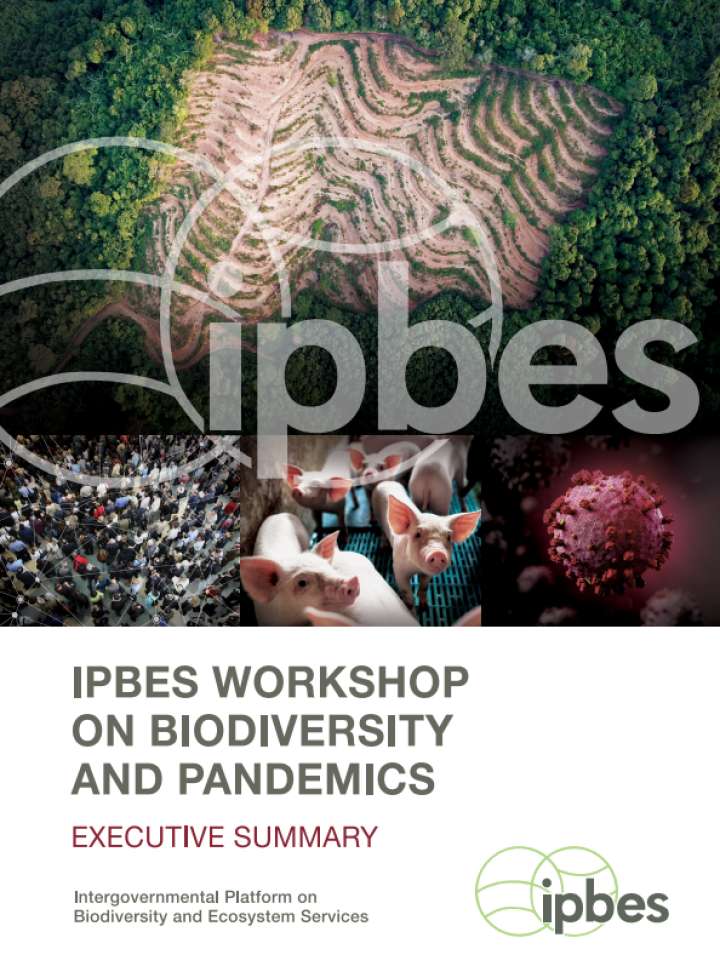IPBES workshop on biodiversity and pandemics: Full report and executive summary
The scientific evidence reviewed in this workshop report demonstrates that pandemics are becoming more frequent, driven by a continued rise in the underlying emerging disease events that spark them. Without preventative strategies, pandemics will emerge more often, spread more rapidly, kill more people, and affect the global economy with more devastating impact than ever before.
The IPBES workshop report is one of the most scientifically robust examinations of the evidence and knowledge about links between pandemic risk and nature since the COVID pandemic began – with contributions from leading experts in fields as diverse as epidemiology, zoology, public health, disease ecology, comparative pathology, veterinary medicine, pharmacology, wildlife health, mathematical modelling, economics, law and public policy.
Current pandemic strategies rely on responding to diseases after their emergence with public health measures and technological solutions, in particular the rapid design and distribution of new vaccines and therapeutics. However, COVID-19 demonstrates that this is a slow and uncertain path, and as the global population waits for vaccines to become available, the human costs are mounting, in lives lost, sickness endured, economic collapse, and lost livelihoods.
This report embraces the need for transformative change and uses scientific evidence to identify policy options to prevent pandemics. Many of these may seem costly, difficult to execute, and their impact uncertain. However, economic analysis suggests their costs will be trivial in comparison to the trillions of dollars of impact due to COVID-19, let alone the rising tide of future diseases. The scientific evidence reviewed here, and the societal and economic impacts of COVID-19 provide a powerful incentive to adopt these policy options and create the transformative change needed to prevent future pandemics. This will provide benefits to health, biodiversity conservation, our economies, and sustainable development. Above all, it will provide a vision of our future in which we have escaped the current ‘Pandemic Era’.
Please find here the key facts and statistics from the report:
- $8 trillion to $16 trillion: estimated cost of the COVID-19 pandemic, including $5.8 trillion to $8.8 trillion of 3 to 6 months of social distancing and travel restrictions (6.4% to 9.7% of global GDP)
- >1 trillion dollars: likely annual global economic damages due to pandemics
- $53 billion: Economic impact of the 2014 Ebola epidemic in West Africa
- $7 billion to $18 billion: Estimated cost of the Zika virus in South America and the Caribbean (2015 to 2017)
- $78 billion to $91 billion: total annual financial allocation for global biodiversity conservation
- >70%: of emerging diseases (e.g. Ebola, Zika, Nipah encephalitis) caused by microbes found in animals (i.e. are classed as zoonotic pathogens) which ‘spill over’ due to contact among wildlife, livestock, and people
- Almost 100%: of pandemics (e.g. influenza, SARS, COVID-19) have been caused by zoonoses
- Up to 1.7 million: current estimate of ‘undiscovered’ viruses in mammal and water birds, the hosts most commonly identified as origins of novel zoonoses
- Less than 2,000: currently catalogued viral diversity from these hosts (less than 0.1% of the potential zoonotic viral risk has been discovered)
- 540,000 to 850,000: estimated number of viruses that could have the ability to infect humans
- 24%: wild terrestrial vertebrate species traded globally
- US$107 billion: value of international legal wildlife trade in 2019, a 500% increase in the last 15 years (since 2005), 2,000% since the 1980s
- $7 billion to $23 billion: annual value of the world’s illegal wildlife trade [data incomplete]
- >400: microbes (viruses, bacteria, protozoa, fungi and other microorganisms) have emerged in people during the last five decades, more than 70% of them originating in animals, mostly wildlife
- At least 6: Pandemics since the Great Influenza pandemic of 1918 -- three caused by influenza viruses, HIV/AIDS, SARS, and COVID-19, and the frequency is increasing
- 3% (~35 million ha): Increase in agricultural area worldwide, 1992 to 2015, mostly converted from tropical forests
- 1 billion ha: anticipated area of land cleared globally by 2050
- >30%: emerging infectious diseases attributed to land use change, agricultural expansion and urbanization
- 75%: approved antimicrobial drugs derived from natural or naturally derived compounds
- 12 million: estimated number of fungal species, one of which was the source of penicillin used to control bacterial infections and revolutionize medicine
- $55 billion: Global economic impact of H1N1 on tourism
Explore further
